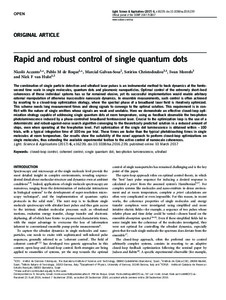Mostra el registre d'ítem simple
Rapid and robust control of single quantum dots
| dc.contributor.author | Accanto, Nicolò |
| dc.contributor.author | Roque Fernández, Pablo Manuel de |
| dc.contributor.author | Galvan-Sosa, Marcial |
| dc.contributor.author | Christodoulou, Sotirios |
| dc.contributor.author | Moreels, Iwan |
| dc.contributor.author | Hulst, Niek F van |
| dc.contributor.other | Universitat Politècnica de Catalunya. Institut de Ciències Fotòniques |
| dc.date.accessioned | 2017-03-10T09:03:00Z |
| dc.date.available | 2017-03-10T09:03:00Z |
| dc.date.issued | 2017-03-10 |
| dc.identifier.citation | Accanto, N. [et al.]. Rapid and robust control of single quantum dots. "Light: Science & Applications", 10 Març 2017, vol. 6, núm. e16239. |
| dc.identifier.issn | 2047-7538 |
| dc.identifier.uri | http://hdl.handle.net/2117/102260 |
| dc.description.abstract | The combination of single particle detection and ultrafast laser pulses is an instrumental method to track dynamics at the femtosecond time scale in single molecules, quantum dots and plasmonic nanoparticles. Optimal control of the extremely short-lived coherences of these individual systems has so far remained elusive, yet its successful implementation would enable arbitrary external manipulation of otherwise inaccessible nanoscale dynamics. In ensemble measurements, such control is often achieved by resorting to a closed-loop optimization strategy, where the spectral phase of a broadband laser field is iteratively optimized. This scheme needs long measurement times and strong signals to converge to the optimal solution. This requirement is in conflict with the nature of single emitters whose signals are weak and unstable. Here we demonstrate an effective closed-loop optimization strategy capable of addressing single quantum dots at room temperature, using as feedback observable the two-photon photoluminescence induced by a phase-controlled broadband femtosecond laser. Crucial to the optimization loop is the use of a deterministic and robust-against-noise search algorithm converging to the theoretically predicted solution in a reduced amount of steps, even when operating at the few-photon level. Full optimization of the single dot luminescence is obtained within ~100 trials, with a typical integration time of 100 ms per trial. These times are faster than the typical photobleaching times in single molecules at room temperature. Our results show the suitability of the novel approach to perform closed-loop optimizations on single molecules, thus extending the available experimental toolbox to the active control of nanoscale coherences. |
| dc.language.iso | eng |
| dc.publisher | Nature |
| dc.rights | Attribution-NonCommercial-NoDerivs 3.0 Spain |
| dc.rights.uri | http://creativecommons.org/licenses/by-nc-nd/3.0/es/ |
| dc.subject | Àrees temàtiques de la UPC::Física |
| dc.subject.lcsh | Quantum dots |
| dc.subject.other | Quantum Dots |
| dc.title | Rapid and robust control of single quantum dots |
| dc.type | Article |
| dc.subject.lemac | Quàntums, Teoria dels |
| dc.description.peerreviewed | Peer Reviewed |
| dc.relation.publisherversion | http://www.nature.com/lsa/journal/v6/n3/full/lsa2016239a.html?WT.feed_name=subjects_biological-sciences |
| dc.rights.access | Open Access |
| dc.description.version | Postprint (published version) |
| dc.relation.projectid | info:eu-repo/grantAgreement/EC/FP7/247330/EU/Nano-Optical Antennas for Tuneable Single Photon Super-Emitters/NANOANTENNAS |
| local.citation.publicationName | Light: Science & Applications |
| local.citation.volume | 6 |
| local.citation.number | e16239 |
Fitxers d'aquest items
Aquest ítem apareix a les col·leccions següents
-
Articles de revista [35]


